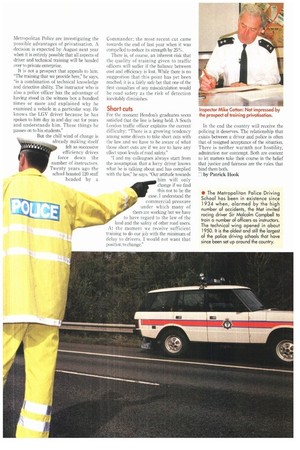TEACHER'S MET
Page 46

Page 47

If you've noticed an error in this article please click here to report it so we can fix it.
At their desks a group of students are being patiently tutored in the finer points of the hydraulic braking system with reference to a full-size working model. In the next classroom another group is having the mysteries of the tachograph explained to them, while on the ground floor a third group is huddled round a stripped down 10-tonne truck—one of a fleet of vehicles available for teaching purposes.
CM is in the Technical Wing of the Metropolitan Police Driving School, Hendon with the senior instructor, Inspector Mike Cotton.
The four instructors are all qualified to the highest levels of City and Guilds, ensuring that students, who come from as far afield as Canada and Japan, receive some of the finest training available anywhere in the world. The walls outside the instructors' suite of offices are covered with certificates of courses attended and passed. In each of the classrooms bits of ironware from bolts to complete engines stand in solid array to aid the learning process. Worn tyres and shorn metal warn of the dangers of faulty or non
existent maintenance. All the students here are graduates of the main driving school and have passed selection as traffic officers. The emblem they proudly display is of a black rat, originally a pejorative label which has its origins in the black helmet and boots that traffic officers once wore but which is now a symbol of the most highly (and expensively) trained police officer in the Service.
The self-induced pressure on the students to succeed was obvious and says much for the motivation required for officers to make it in the modern-day traffic patrol.
But why the need for such extensive training—and couldn't part of their work be done more cheaply by less qualified personnel? "Traffic officers are frequently called to the scenes of accidents where allegations are made about the roadworthiness of the vehicles concerned, the speed on impact or the probable cause," says Cotton. "In addition to that officers are responsible for detecting breaches of driver hours legislation, Construction and Use Regulations and much else in the course of their daily work. They may, as a result, have to satisfy the magistrate or coroner as to who or what was to blame.
"Because of their training and experience," he adds, "these officers will already be familiar with the workings of the courts and the complicated business of collecting and preserving exhibits. They will know exactly what to look for and how to present the evidence.
"While these are all skills that can be learned and carried out more cheaply by any competent person," says Cotton, "they do take time In the meantime it is important that the officers whose job it is to enquire into the causes of accidents or investigate road traffic offences are qualified to do so."
The problem for Cotton, as he is well aware, is that the school may not exist in its present form for much longer. The Metropolitan Police are investigating the possible advantages of privatisation. A decision is expected by August next year when it is entirely possible that all aspects of driver and technical training will be handed over to private enterprise.
It is not a prospect that appeals to him. "The training that we provide here," he says, "is a combination of technical knowledge and detective ability. The instructor who is also a police officer has the advantage of having stood in the witness box a hundred times or more and explained why he examined a vehicle in a particular way. He knows the LGV driver because he has spoken to him day in and day out for years and understands him. These things he passes on to his students."
But the chill wind of change is already making itself felt as successive efficiency drives force down the number of instructors. Twenty years ago the school boasted 120 staff headed by a Commander; the most recent cut came towards the end of last year when it was compelled to reduce its strength by 25%.
There is, of course, an inherent risk that the quality of training given to traffic officers will suffer if the balance between cost and efficiency is lost. While there is no suggestion that this point has yet been reached, it is a fairly safe bet that one of the first casualties of any miscalculation would be road safety as the risk of detection inevitably diminishes.
Short cuts
For the moment Hendon's graduates seem satisfied that the line is being held. A South London traffic officer explains the current difficulty: "There is a growing tendency among some drivers to take short cuts with the law and we have to be aware of what those short cuts are if we are to have any effect upon levels of road safety."
"I and my colleagues always start from the assumption that a lorry driver knows what he is talking about and has complied with the law," he says, "Our attitude towards him will only change if we find this not to be the case. I understand the commercial pressure under which many of them are working but we have to have regard to the law of the land and the safety of other road users. At the moment we receive sufficient training to do our job with the minimum of delay to drivers. I would not want that position to change."
In the end the country will receive the policing it deserves. The relationship that exists between a driver and police is often that of resigned acceptance of the situation. There is neither warmth nor hostility, admiration nor contempt. Both are content to let matters take their course in the belief that justice and fairness are the rules that bind them both.
71 by Patrick Hook




























































































